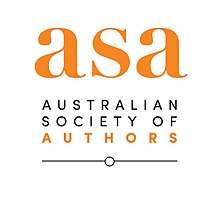Australian Society of Authors

The ASA was formed in 1963 as the peak organisation to promote and protect the rights of Australia's authors and illustrators. The organisation established Public Lending Right (PLR) in 1975 and Educational Lending Right (ELR) in 2000. The ASA was also instrumental in setting up Copyright Agency, the Australian Copyright Council and the International Authors Forum.
The ASA provides information and advice on all aspects of writing and publishing.
Founding
In October 1962 President of the NSW Federation of Australian Writers, Walter Stone, invited delegates from all other writers' societies to a meeting in Sydney to discuss the formation of a national organisation to represent professional authors. A series of meetings followed culminating in the formation of the ASA on 15 May 1963, and the acceptance of a provisional constitution on 26 June 1963.[1]
Miles Franklin Award winning author Dal Stivens became the founding President of the ASA in 1963.
The poet Jill Hellyer was the first Executive Secretary and received an honorarium of ₤10 a week. Her home in Mt Colah became the ASA's first official address.Vice presidents were the novelist Morris West and the critic and sometime publisher P.R. ("Inky") Stephensen. The treasurer was bookseller A.W. Sheppard, and printer Walter Stone was the editor of the new society's journal Broadside (which would later become[2] Australian Author). Other authors on the first committee and council included Nancy Cato, Nan Chauncy, C.B. Christesen, Joan Clarke, Dymphna Cusack, Frank Dalby Davison, Mary Durack Miller, John K. Ewers, Sir Keith Hancock, Xavier Herbert, A. D. Hope, Leonard Mann, Alan Marshall, David Martin, T. Inglis Moore, John O'Grady, Roland Robinson, Colin Simpson, Douglas Stewart, Judith Wright, Betty Roland, and Alan Yates.
Campaigns and Services
The ASA's first campaign was to abolish the "colonial royalty", by which Australian authors published by British publishers were paid a 10% royalty on book sales in the UK but only a 5% royalty on books sold in Australia, which were considered "export sales". There were also campaigns for an "open market" for books in Australia in an attempt to break the monopoly of British publishers.
The ASA also crusaded to convince a succession of governments that Public Lending Right (PLR) is legitimate recompense to authors for loss of sales when their books are held in Australian public libraries. In 1975, PLR was finally brought in. However, for another 25 years the ASA continued to cajole, argue and lobby for Educational Lending Right (ELR) to be introduced. Efforts were finally rewarded in 2000 when ELR was included as part of the Howard Government's GST compensation package to the book industry. These days, the PLR scheme makes payments to eligible Australian creators and publishers whose books are held in public lending libraries, while the ELR scheme makes similar payments for books held in educational libraries.
The ASA was instrumental in setting up Copyright Agency, which pays creators whose work is copied under statutory licence. This work has resulted in payments of around $100 million distributed to Australian creators every year. The ASA also helped set up the Australian Copyright Council which provides information to the public on intellectual property issues.
The ASA has regularly defended authors against various governments' moves to remove territorial copyright on books. Known as "parallel importation", the repeal of territorial copyright would see a contraction of the Australian publishing industry and ultimately fewer opportunities for Australian authors to achieve publication and meaningful remuneration for their books.
Awards
Among many other awards the ASA administers the Barbara Jefferis Award,[3] which is funded from a bequest from the late John Hinde in tribute to his wife who was a founding member of the Society. The Award was first presented in 2008 (to Rhyll McMaster for her book Feather Man, Brandl & Schlesinger, Sydney, 2007).[4]
The Society received a bequest of the copyright of author Mouni Sadhu (Mieczyslaw Sudowski) in 1972 and currently administers the rights for the works of this author.[5] In 2008, the ASA was bequeathed the literary estate of founder Dal Stivens by his heir Juanita Cragen.[6]
July 2013, Edel Wignell bequeathed her writing earnings and copyright to the ASA.[7]
Structure
The Society now has over 3,000 members, and a staff of six based in the society-owned building in Ultimo, an inner city suburb of Sydney.
Juliet Rogers is the current CEO.[8] The current Chair of the Society is David Day (historian).
Notes
- ↑ "Our History - Australian Society of Authors (ASA)". www.asauthors.org. Retrieved 2017-09-27.
- ↑ asauthors.org at the Library of Congress Web Archives (archived 2011-08-04)
- ↑ "Services - Australian Society of Authors (ASA)". www.asauthors.org. Retrieved 2017-09-27.
- ↑ Barbara Jefferis Award
- ↑ http://www.mounisadhu.com/
- ↑ "Dal Stivens Bequest". Australian Society of Authors. Archived from the original on 7 February 2015. Retrieved 17 February 2015.
- ↑ "Australian Writer, Compiler and Journalist | Edel Wignell". www.edelwignell.com.au. Retrieved 2017-09-27.
- ↑ "Our Staff - Australian Society of Authors (ASA)". www.asauthors.org. Retrieved 2017-09-27.
Books
- Hill, Deirdre (1983). A Writer's Rights: the Story of the Australian Society of Authors 1963-1983. Sydney: Australian and New Zealand Book Co. ISBN 9780855521424.
External links
- Official website
- "The Style File". ASA.
Showcasing Australian Illustrators